i-ACTIVSENSE
Camera and Sensors
Forward Sensing Camera (FSC)
The Forward Sensing Camera (FSC) detects lane indications and recognizes headlights, taillights and city lights during nighttime driving. In addition, it also detects the vehicle ahead, pedestrians, or obstructions. The following systems use the Forward Sensing Camera (FSC).
-
High Beam Control system (HBC)
-
Lane Departure Warning System (LDWS)
-
Traffic Sign Recognition System (TSR)
-
Distance & Speed Alert (DSA)
-
Driver Attention Alert (DAA)
-
Mazda Radar Cruise Control (MRCC)
-
Mazda Radar Cruise Control with Stop & Go function (MRCC with Stop & Go function)
-
Lane-keep Assist System (LAS)
-
Traffic Jam Assist (TJA)
-
Smart Brake Support (SBS) forward drive detection
The Forward Sensing Camera (FSC) is installed at the top of the windshield near the rearview mirror.
Refer to Forward Sensing Camera (FSC) (Search).
Front radar sensor
The front radar sensor detects radio waves reflected off a vehicle ahead sent from the radar sensor. The following systems use the front radar sensor.
-
Distance & Speed Alert (DSA)
-
Mazda Radar Cruise Control (MRCC)
-
Mazda Radar Cruise Control with Stop & Go function (MRCC with Stop & Go function)
-
Traffic Jam Assist (TJA)
-
Smart Brake Support (SBS) forward drive detection
The front radar sensor is mounted behind the radiator grille.
Refer to Front Radar Sensor (Search).
Front side radar sensor
The front side radar sensors detects radio waves reflected off a vehicle ahead sent from the radar sensor. The following systems use the front side radar sensor.
-
Front Cross Traffic Alert (FCTA)
The front side radar sensors are installed inside the front bumper, one on the left side and one on the right side.
Refer to Front Side Radar Sensor (Search).
Rear side radar sensor
The rear side radar sensors emit radio waves and detect the radio waves reflected off a vehicle approaching from the rear or an obstruction. The following systems use the rear side radar sensor.
-
Blind Spot Monitoring (BSM)
-
Rear Cross Traffic Alert (RCTA)
-
Smart Brake Support (SBS) reverse drive detection
The rear side radar sensors are installed inside the rear bumper, one on the left side and one on the right side.
Refer to Rear Side Radar Sensor (Search).
Rear/rear corner ultrasonic sensor
The ultrasonic sensor detects ultrasonic waves reflected off obstructions at the rear sent from the ultrasonic sensors. The following systems use the ultrasonic sensor.
-
Smart Brake Support (SBS) reverse drive detection
The ultrasonic sensors are mounted in the rear bumper.
Refer to Rear/Rear corner Ultrasonic Sensor (Search).
Front camera/side cameras/rear camera
The front camera, side cameras, and rear camera shoot images of the area surrounding the vehicle. The 360° View Monitor uses each camera.
Cameras are installed to the front bumper, door mirrors, and rear bumper.
Refer to Front Camera/Side Cameras/Rear Camera (Search).
Driver monitoring camera
The driver monitoring camera detects changes in the driver's facial features and estimates the amount of accumulated fatigue and sleepiness of the driver. The following systems use the driver monitoring camera.
-
Driver Monitoring (DM)
The driver monitoring camera is mounted in the center display.
Refer to Driver Monitoring Camera (Search).
Adaptive Front Lighting System (AFS)
The adaptive front lighting system (AFS) automatically adjusts the headlight beams to the left or right in conjunction with the operation of the steering wheel after the headlights have been turned on and the vehicle speed is about 2 km/h (2 mph) or higher.
A system malfunction or operation conditions are indicated by a warning.
Refer to Exterior Light Warning Indication/Warning Light (Search).
The Adaptive Front Lighting System (AFS) can be switched to on/off using the personalization function.
Refer to the Settings section in the Mazda Connect Owner's Manual.
High Beam Control System (HBC)
To Operate the System
The HBC operates to switch the headlights automatically between high and low beams after the ignition is switched ON and the headlight switch is in the AUTO and low beam position.
The HBC determines that it is dark based on the brightness of the surrounding area. At the same time, the HBC indicator light (green) in the instrument cluster illuminates.

Operation of the HBC function can be disabled.
Refer to the Settings section in the Mazda Connect Owner's Manual.
Lane Departure Warning System (LDWS)
The LDWS alerts the driver that the vehicle may be deviating from its lane. The system detects the white (yellow) lines on the traffic lane using the forward sensing camera (FSC) and if it determines that the vehicle might be deviating from its lane, it notifies the driver by the LDWS.
Refer to Forward Sensing Camera (FSC) (Search).
Use the LDWS when you drive the vehicle on roads with white (yellow) lines.
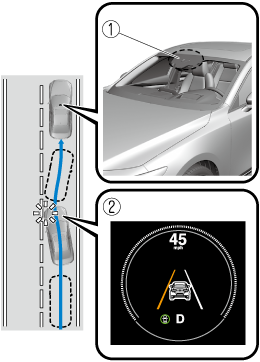
-
Forward sensing camera (FSC)
-
Multi-information display
Do not rely completely on the LDWS:
-
The LDWS system is not designed to compensate for a driver’s lack of caution and relying too much on the system could lead to an accident.
-
The functions of the LDWS have limitations. Always stay on course using the steering wheel and drive with care.
Heed the following cautions so that the LDWS can operate normally.
-
Do not modify the vehicle's suspensions.
-
Always use tires of the specified type and size for the front and rear wheels. Consult an Authorized Mazda Dealer for tire replacement.
The system may not operate normally under the following conditions.
-
The white (yellow) lane lines are less visible because of dirt or paint flaking.
-
White (yellow) lane lines are less visible because of bad weather (rain, fog, or snow).
-
The vehicle is driven on a temporary lane or section with a closed lane resulting from construction where there might be multiple white (yellow) lane lines, or they are interrupted.
-
The camera picks up an obscure line, such as a temporary line being used for construction, or because of shade, unmelted snow, or grooves filled with water.
-
The surrounding brightness suddenly changes such as when entering or exiting a tunnel.
-
Back-light is reflected off the road surface.
-
The road surface is wet and shiny after rain, or there are puddles on the road.
-
The width of a lane is excessively narrow.
-
The vehicle is driven on roads with tight curves.
-
Heavy luggage is loaded in the trunk/luggage compartment or on the rear seat causing the vehicle to tilt.
-
The vehicle is driven through a fork in the road or a junction.
-
The shade of a guardrail parallel to a white (yellow) lane line is cast on the road.
-
The illumination of the headlights is weakened because of dirt or the optical axis is deviated at night.
-
The road is excessively uneven.
-
The vehicle is shaken after hitting a road bump.
-
A vehicle in front of your vehicle is running near a white (yellow) lane line making it less visible.
-
The windshield is dirty or foggy.
-
Strong light is directed from the front of the vehicle (such as sunlight, or headlights (high-beam) of on-coming vehicles).
-
The vehicle is driven through an intersection or a roundabout.
When the System Operates
When the ignition is switched ON, the i-ACTIVSENSE status symbol (warning/risk avoidance support system) (white) turns on and the system goes on standby.

If the i-ACTIVSENSE status symbol (warning/risk avoidance support system) (white) does not turn on, the system is canceled using the i-ACTIVSENSE OFF switch or the personalization feature.
Operation conditions
When all of the following conditions are met, the i-ACTIVSENSE status symbol (warning/risk avoidance support system) on the multi-information display changes from white to green and the system becomes operational.
-
The ignition is switched ON.
-
The vehicle speed is about 64 km/h (40 mph) or faster.
-
The system detects white (yellow) lane lines.

When the system does not detect a white (yellow) lane line on one side only, the system does not operate on the side that is not being detected.
When temporarily canceling the system
The LDWS goes on standby in the following cases: The LDWS operation is automatically restored when the system's operation conditions are met.
-
The system cannot detect white (yellow) lane lines.
-
The vehicle speed is less than about 56 km/h (35 mph).
-
The turn signal lever is operated.
-
The accelerator pedal is depressed.
-
The steering wheel is operated.
-
The brake pedal is operated.
The function is temporarily stopped.
The LDWS stops functioning in the following cases:
-
The temperature in the forward sensing camera (FSC) is too high or too low.
-
The windshield around the forward sensing camera (FSC) is foggy.
-
The windshield around the forward sensing camera (FSC) is blocked by an obstruction, causing poor forward visibility.
-
Strong light (such as sunlight, or headlights (high-beam) of on-coming vehicles) is directed at the forward sensing camera (FSC).
System malfunction
If there is a problem with the system, the i-ACTIVSENSE status symbol (warning/risk avoidance support system) (white) and the i-ACTIVSENSE warning indication/warning light on the multi-information display turns on and a message is indicated.
Refer to i-ACTIVSENSE Status Symbol (Warning/Risk Avoidance Support System) (Search).
LDWS Warning
If the system determines that the vehicle may deviate from its lane, a warning (beep sound, steering wheel vibration) is activated and the direction in which the system determines that the vehicle may deviate is indicated on the multi-information display.
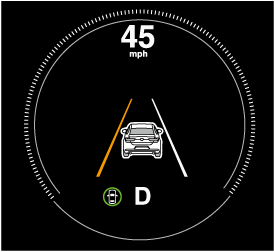
-
The LDWS settings can be changed.
Refer to the Settings section in the Mazda Connect Owner's Manual.
-
You may not be able to hear the LDWS warning sound depending on the surrounding conditions such as outside noise.
-
If you set the LDWS to vibrate the steering wheel, you may not feel the vibrations depending on the road surface conditions.
Blind Spot Monitoring (BSM) (Some Models)
Blind Spot Monitoring (BSM)
The BSM is designed to assist the driver in checking the area to the rear of the vehicle on both sides during lane changes by notifying the driver of the presence of vehicles approaching from the rear in an adjacent lane.
BSM operation
The BSM detects vehicles approaching from the rear while traveling in the forward direction at a speed of 10 km/h (6.3 mph) or faster and notifies the driver by turning on the BSM warning indicator light and displaying the vehicle detection screen.
If the turn signal lever is operated to signal a turn in the direction in which the BSM warning indicator light is illuminated while the approaching vehicle is detected, the BSM notifies the driver of possible danger flashing on the BSM warning indicator light, and by activating the warning sound and the warning screen indicator display.
The detection area on this system covers the driving lanes on both sides of the vehicle and from the rear part of the front doors to about 50 m (164 ft) behind the vehicle.
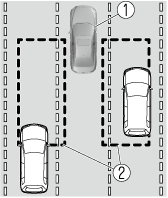
-
Your vehicle
-
Detection areas
Always check the surrounding area visually before making an actual lane change:
The system is only designed to assist you in checking for vehicles at your rear when making a lane change. Due to certain limitations with the operation of this system, the BSM warning indicator light, the warning sound and the warning screen indicator display may not activate or they might be delayed even though a vehicle is in an adjacent driving lane. Always make it your responsibility as a driver to check the rear.
-
The BSM will operate when all of the following conditions are met:
-
The ignition is switched ON.
-
The i-ACTIVSENSE warning indication/warning light in the instrument cluster is turned off.
-
The vehicle speed is about 10 km/h (6.3 mph) or faster.
-
-
The BSM will not operate under the following circumstances.
-
The vehicle speed falls below about 10 km/h (6.3 mph) even though the i-ACTIVSENSE warning indication/warning light is turned off.
-
The shift lever (manual transmission)/selector lever (automatic transmission) is shifted to reverse (R) and the vehicle is reversing.
-
The turning radius is small (making a sharp turn, turning at intersections).
-
-
In the following cases, the i-ACTIVSENSE warning indication/warning light turns on and operation of the system is stopped. If the i-ACTIVSENSE warning indication/warning light remains illuminated, have the vehicle inspected at an Authorized Mazda Dealer as soon as possible.
-
Some problem with the system including the BSM warning indicator lights is detected.
-
A large deviation in the installation position of a rear side radar sensor on the vehicle has occurred.
-
There is a large accumulation of snow or ice on the rear bumper near a rear side radar sensor. Remove any snow, ice or mud on the rear bumper.
-
Driving on snow-covered roads for long periods.
-
The temperature near the rear side radar sensor becomes extremely hot due to driving for long periods on slopes during the summer.
-
The battery voltage has decreased.
-
-
Under the following conditions, the rear side radar sensor cannot detect target objects or it may be difficult to detect them.
-
The rear bumper around the rear side radar sensor is deformed.
-
Radio wave interference from a radar sensor equipped on a nearby vehicle.
-
The approaching vehicle is any of the following shapes.
-
The size of the vehicle body is extremely small.
-
The vehicle height is extremely low or high.
-
A special type of vehicle with a complex shape.
-
-
A vehicle is in the detection area at the rear in an adjacent driving lane but it does not approach. The BSM determines the condition based on radar detection data.
-
A vehicle is traveling alongside your vehicle at nearly the same speed for an extended period of time.
-
Vehicles approaching in the opposite direction.
-
A vehicle in an adjacent driving lane is attempting to pass your vehicle.
-
A vehicle is in an adjacent lane on a road with extremely wide driving lanes. The detection area of the rear side radar sensor is set at the road width of expressways.
-
-
In the following case, the flashing of the BSM warning indicator light, and the activation of the warning sound and the warning screen indicator display may not occur or they may be delayed.
-
A vehicle makes a lane change from a driving lane two lanes over to an adjacent lane.
-
Driving on steep slopes.
-
Crossing the summit of a hill or mountain pass.
-
When there is a difference in the height between your driving lane and the adjacent lane.
-
Directly after the BSM system becomes operable by changing the setting.
-
-
If the road width is extremely narrow, vehicles two lanes over may be detected. The detection area of the rear side radar sensor is set according to the road width of expressways.
-
The BSM warning indicator light may turn on and the vehicle detection screen may be displayed in the display in reaction to stationary objects (guardrails, tunnels, sidewalls, and parked vehicles) on the road or the roadside.
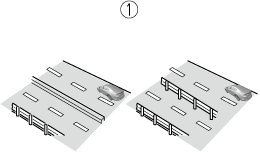
-
Objects such as guardrails and concrete walls running alongside the vehicle.

-
Places where the width between guardrails or walls on each side of the vehicle narrows.
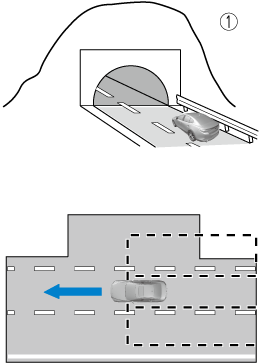
-
The walls at the entrance and exits of tunnels, turnouts.
-
-
A BSM warning indicator light may flash or the warning beep may be activated several times when making a turn at a city intersection.
-
Turn off the BSM while pulling a trailer or while an accessory such as a bicycle carrier is installed to the rear of the vehicle. Otherwise, the radar’s radio waves will be blocked causing the system to not operate normally.
-
In the following cases, it may be difficult to view the illumination/flashing of the BSM warning indicator lights equipped on the door mirrors.
-
Snow or ice is adhering to the door mirrors.
-
The front door glass is fogged or covered in snow, frost or dirt.
-
-
The rear side radar sensor of the BSM may be regulated under the radio wave related laws of the country where the vehicle is driven. If this system is used abroad, it may be necessary to turn off the system.
Refer to Rear Side Radar Sensor (Search).
-
The system switches to the Rear Cross Traffic Alert (RCTA) function when the shift lever (manual transmission) or the selector lever (automatic transmission) is shifted to the reverse (R) position.
Refer to Rear Cross Traffic Alert (RCTA) (Search).
Canceling Operation of Blind Spot Monitoring (BSM)
The BSM system can be set to inoperable.
-
(If only the BSM is turned off)
Refer to the Settings section in the Mazda Connect Owner's Manual.
-
(If the BSM is turned off by operating the i-ACTIVSENSE OFF switch)
Refer to i-ACTIVSENSE OFF Switch (Search).
If the ignition is switched OFF while you have canceled the system using the i-ACTIVSENSE OFF switch, the system is automatically enabled the next time the ignition is switched ON. However, if the system is canceled using the personalization features, the system is not automatically enabled.
Vehicle Ahead Close Proximity Warning
When the system determines that the distance between your vehicle and a vehicle ahead is close, the i-ACTIVSENSE status symbol (warning/risk avoidance support system) changes from green to amber and the warning indication is displayed on the multi-information display. While checking the safety of the surrounding area, depress the brake pedal while keeping a safe distance from the vehicle ahead.
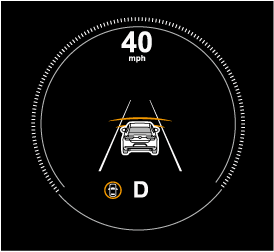
Driver Attention Alert (DAA)
The DAA is a system which detects driver fatigue and decreased attentiveness, and encourages the driver to take a rest.
When the vehicle is driven inside traffic lane lines at about 65 to 140 km/h (41 to 86 mph), the DAA estimates the amount of accumulated fatigue and decreased attentiveness of the driver based on the information from the Forward Sensing Camera (FSC) and other vehicle information, and encourages the driver to take a rest using an indication on the multi-information display and a warning sound.
Use the DAA on expressways or highways.
Refer to Forward Sensing Camera (FSC) (Search).
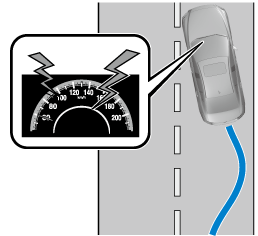
Do not rely completely on DAA and always drive carefully:
The DAA detects driver fatigue and decreased attentiveness and encourages the driver to take a rest, however, it is not designed to prevent the vehicle from straying. If you rely too much on the DAA it could lead to an accident. Drive carefully and operate the steering wheel appropriately.
In addition, the system may not be able to detect driver fatigue and decreased attentiveness correctly depending on the traffic and driving conditions. The driver must take sufficient rest in order to drive safely.
-
The DAA operates when all of the following conditions are met.
-
The vehicle speed is about 65 to 140 km/h (41 to 86 mph).
-
The system detects white (yellow) lane lines.
-
The system has completed learning of the driver’s driving data after 60 minutes have passed since the driver began driving vehicle.
-
-
The DAA does not operate under the following conditions.
-
The vehicle speed is less than about 65 km/h (41 mph).
-
The vehicle speed exceeds about 140 km/h (86 mph).
-
The vehicle is making a sharp turn.
-
The vehicle is changing lanes.
-
The system cannot detect white (yellow) lane lines.
-
-
The DAA may not operate normally under the following conditions.
-
White (yellow) lane lines are less visible because of dirt or fading/patchiness.
-
The vehicle is jolted or swayed continuously by strong winds or rough roads.
-
The vehicle is driven aggressively.
-
When making frequent lane changes.
-
The vehicle is making a curve.
-
-
The DAA detects driver fatigue and decreased attentiveness based on the driving data when the vehicle is driven at about 65 to 140 km/h (41 to 86 mph) for about 20 minutes. The driving data will be reset under the following conditions.
-
The vehicle is stopped for 15 minutes or longer.
-
The vehicle is driven at less than about 65 km/h (41 mph) for about 30 minutes.
-
The ignition is switched off.
-
-
After the DAA has displayed the first message encouraging rest, it does not display the next one until 60 minutes have passed.
Driver Monitoring (DM) (Some Models)
Driver Monitoring (DM) Display
When the Driver Monitoring (DM) detects driver fatigue or sleepiness, it activates the warning sound and displays an alert in the instrument cluster.
Warning pattern (caution) (white)
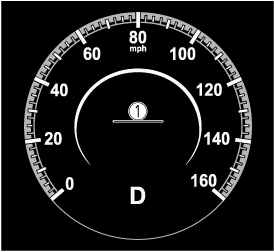
-
“Time for a Break” message is displayed
Warning pattern (warning) (amber)
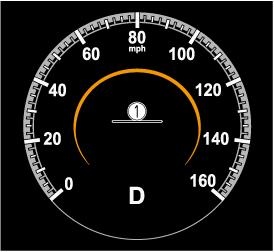
-
“Time for a Break” message is displayed
Front Cross Traffic Alert (FCTA) (Some Models)
Canceling Operation of Rear Cross Traffic Alert (RCTA)
The RCTA can be set to inoperable.
-
(If only the RCTA is turned off)
Refer to the Settings section in the Mazda Connect Owner's Manual.
-
(If the RCTA is turned off by operating the i-ACTIVSENSE OFF switch)
Refer to i-ACTIVSENSE OFF Switch (Search).
If the ignition is switched OFF while you have canceled the system using the i-ACTIVSENSE OFF switch, the system is automatically enabled the next time the ignition is switched ON. However, if the system is canceled using the personalization features, the system is not automatically enabled.
Setting the System
The MRCC with Stop & Go function system operates when all of the following conditions are met.
-
Vehicle speed is 0 km/h (0 mph) to 145 km/h (90 mph)
-
The MRCC with Stop & Go function is turned on.
-
The brake pedal is not depressed.
-
The parking brake is released (Electric Parking Brake (EPB) indicator light is turned off).
-
There is no problem with the DSC.
-
All the doors are closed.
-
The driver's seat belt is fastened.
-
The selector lever is in the drive (D) position or manual (M) position (manual mode).
-
In the following cases, the MRCC with Stop & Go function system is canceled when the vehicle is traveling at 30 km/h (20 mph) or less and “Mazda Radar Cruise Control Disabled Under 30 km/h” is displayed in the multi-information display.
-
The Forward Sensing Camera (FSC) cannot detect target objects (There is problem with the Forward Sensing Camera (FSC) or windshield is dirty).
-
There is a problem with the stop hold control function.
-
There is a problem with the Electric Parking Brake (EPB).
-
-
It may not be possible to set the MRCC with Stop & Go function system directly after starting the engine, while the DSC operation is being checked.
Turning on the system
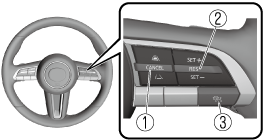
-
CANCEL switch
-
RES switch
-
MRCC switch
When the MRCC switch is pressed once, the MRCC with Stop & Go function system turns on, and the MRCC with Stop & Go function standby indication (white) turns on and the vehicle speed and the distance between the vehicles while in headway control can be set.

In addition, the MRCC with Stop & Go function system display indication is displayed on the multi-information display and the active driving display at the same time.
If the ignition is switched off while the MRCC with Stop & Go function system is operating, the system will be operable when the ignition is switched ON the next time.
How to set the speed
Adjust the vehicle speed to the desired setting using the accelerator pedal and press the RES switch up (SET+) or down (SET-) to start headway control.
The set speed is indicated on the display. At the same time, the MRCC standby indication (white) changes to the MRCC set indication (green).

|
Travel status |
Indication on multi-information display |
Indication on active driving display (vehicles with active driving display) |
|---|---|---|
|
During travel at constant speed |
 |
 |
|
During travel under headway control |
 |
 |
-
If a vehicle ahead is detected while traveling at a constant speed, the vehicle-ahead indication is displayed and headway control is performed. Additionally, when a vehicle ahead is no longer detected, the vehicle-ahead indication turns off and the system switches back to travel at constant speed.
-
The lowest possible speed which can be set on the MRCC with Stop & Go function system is 30 km/h (19 mph).
-
Headway control is not possible if the vehicle ahead is driving faster than your vehicle's set speed. Adjust the system to the desired vehicle speed using the accelerator pedal.
How to set the distance-between-vehicles during headway control
The distance-between-vehicles can be set to 4 levels; Long, medium, short, and extremely short distance.
The distance-between-vehicles is set to a shorter distance by pressing the CANCEL switch down. The distance-between-vehicles is set to a longer distance by pressing the CANCEL switch up.
|
Distance-between-vehicles guideline (at 80 km/h (50 mph) vehicle speed) |
Indication on multi-information display |
Indication on active driving display (vehicles with active driving display)*1 |
|---|---|---|
|
Long (about 50 m (164 ft)) |
 |
 |
|
Medium (about 40 m (131 ft)) |
 |
 |
|
Short (about 30 m (98 ft)) |
 |
 |
|
Extremely short (about 25 m (82 ft)) |
 |
 |
-
Displays a pop-up image in the active driving display only when the driver operates the switch.
-
The distance-between-vehicles differs depending on the vehicle speed, and the slower the vehicle speed, the shorter the distance.
-
When the ignition is switched to ACC or OFF and then the engine is started again, the system automatically sets the distance-between-vehicles to the previous setting.
Changing the Set Vehicle Speed
(To accelerate/decelerate using the RES switch)
When the RES switch is pressed up (SET+), the vehicle accelerates and when the RES switch is pressed down (SET-), it decelerates.
-
Press and release immediately: 1 km/h (1 mph)
-
Press and hold: 10 km/h (5 mph)
(To increase speed using accelerator pedal)
Depress the accelerator pedal and press the RES switch up (SET+) or down (SET-) at the desired speed. If the switch is not operated, the system returns to the set speed after you release your foot from the accelerator pedal.
-
The warnings and brake control do not operate while the accelerator pedal is depressed.
-
The setting speed can be changed by operating the RES switch up (SET+) or down (SET-) during stop hold control.
Canceling the system
When the following operations are performed, the MRCC with Stop & Go function system is canceled, and the MRCC with Stop & Go function set indication (green) switches to the MRCC with Stop & Go function standby indication (white) at the same time.
-
The CANCEL switch is pressed.
-
The brake pedal is depressed.
-
The selector lever is in the P (Park), N (Neutral), or R (Reverse) position.
Under the following conditions, the MRCC with Stop & Go function cancel indication is displayed in the multi-information display and a single beep sound is heard.
-
The DSC has operated.
-
The Smart Brake Support (SBS) has operated.
-
When traveling on a downslope for a long period of time.
-
There is a problem with the system.
-
The parking brake is automatically applied during stop hold control.
-
The front radar sensor cannot detect target objects (during rain, fog, snow or other inclement weather conditions, or when the radiator grille is dirty).
-
The parking brake is applied.
-
Any of the doors is opened.
-
The driver's seat belt is unfastened.
-
The operation frequency of the braking by the MRCC with Stop & Go function control is high.
Resuming control
If the MRCC with Stop & Go function system is canceled, you can resume control at the previously set speed by pressing the RES switch and after all of the operation conditions have been met.
If the set speed is not indicated in the display, the control does not resume even if the RES switch is pressed.
Turning off the system
When the MRCC switch is pressed while the MRCC is operating, the MRCC turns off.
Close Proximity Warning
If your vehicle rapidly closes in on the vehicle ahead while you are traveling under headway control, the warning sound is activated and the brake warning is indicated on the display. Keep a safe distance between your vehicle and a vehicle ahead.

-
“Depress Brake Pedal” message is displayed
In the following cases, the warnings and brakes may not operate even if your vehicle starts closing in on the vehicle ahead.
-
You are driving your vehicle at the same speed as the vehicle ahead.
-
Directly after the TJA operates.
-
Directly after the accelerator pedal is released.
-
Another vehicle cuts into the driving lane in front of you.
Setting the System
Operation conditions
Headway control function
The TJA operates when all of the following conditions are met.
-
(Automatic transmission vehicle)
-
The vehicle speed is about 0 km/h (0 mph) to 145 km/h (90 mph).
-
The selector lever is in the D or M position (manual mode).
-
-
(Manual transmission vehicle)
-
The vehicle speed is about 30 km/h (19 mph) to 145 km/h (90 mph).
-
The shift lever is in a position other than the R or N position.
-
The clutch pedal is not depressed.
-
-
The TJA is operating.
-
The headway control function of the Mazda Radar Cruise Control (MRCC) or Mazda Radar Cruise Control with Stop & Go function (MRCC with Stop & Go function) is set to operable (if it was set to inoperable, set it to operable using the personalization function).
-
The brake pedal is not depressed.
-
The parking brake is released (Electric Parking Brake (EPB) indicator light is turned off).
-
There is no problem with the DSC.
-
All the doors are closed.
-
The driver's seat belt is fastened.
(Automatic transmission vehicle)
-
Under the following conditions, the TJA cannot be used when the vehicle speed is 30 km/h (19 mph) or slower.
-
There is a problem with the stop hold control function.
-
There is a problem with the Electric Parking Brake (EPB).
-
-
The TJA may not launch directly after the engine starts.
Steering assist function
The steering assist function operates when all of the following conditions are met.
-
Your vehicle is moving and less than about 56 km/h (35 mph).
-
White (yellow) lane lines on both sides are detected and you are driving near the center of the lane, or your vehicle detects a vehicle ahead.
-
The steering wheel is not turned sharply.
-
The turn signal lever is not operated.
-
The headway control function is operating.
-
(Manual transmission vehicle)
The vehicle speed is about 30 km/h (19 mph) or faster.
-
The steering assist function operates so that the vehicle remains near the center of the driving lane, however, depending on conditions such as the road curvature, road slope and undulations, and vehicle speed, the function might not be able to keep the vehicle near the center of the driving lane.
Setting method
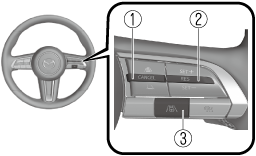
-
CANCEL switch
-
RES switch
-
TJA switch
-
Press the TJA switch.
The TJA standby indication (white) turns on. In addition, the TJA display indication is displayed on the multi-information display at the same time.
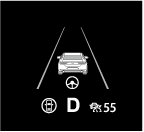
-
Adjust the vehicle speed to the desired setting using the accelerator pedal and press the RES switch up (SET+) or down (SET-) to start headway control.
The set speed is indicated on the display. At the same time, the TJA standby indication (white) changes to the TJA set indication (green).
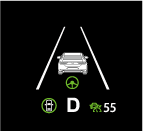
-
The headway control is operable when all of the conditions for it to operate are met, or the steering assist function is operable when all of the conditions for it to operate are met.
-
If a vehicle ahead is detected while traveling at a constant speed, the vehicle-ahead indication is displayed and headway control is performed. Additionally, when a vehicle ahead is no longer detected, the vehicle-ahead indication turns off and the system switches back to travel at constant speed.
-
Headway control is not possible if the vehicle ahead is driving faster than your vehicle's set speed. Adjust the system to the desired vehicle speed using the accelerator pedal.
-
When the ignition is switched OFF, the system status before it was turned off is maintained. For example, if the ignition is switched OFF with the TJA operable, the TJA remains operational the next time the ignition is switched ON.
-
When the TJA switch is pressed while the Mazda Radar Cruise Control (MRCC) or Mazda Radar Cruise Control with Stop & Go function (MRCC with Stop & Go function) system is operating, the TJA operates. In addition, when the MRCC switch is pressed while the TJA is operating, the Mazda Radar Cruise Control (MRCC) or Mazda Radar Cruise Control with Stop & Go function (MRCC with Stop & Go function) system operates.
Changing the set vehicle speed
(To accelerate/decelerate using the RES switch)
When the RES switch is pressed up (SET+), the vehicle accelerates and when the RES switch is pressed down (SET-), it decelerates.
-
Press and release immediately: 1 km/h (1 mph)
-
Press and hold: 10 km/h (5 mph)
(To increase speed using accelerator pedal)
Depress the accelerator pedal and press the RES switch up (SET+) or down (SET-) at the desired speed. If the switch is not operated, the system returns to the set speed after you release your foot from the accelerator pedal.
-
The warnings and brake control do not operate while depressing the accelerator pedal.
-
The lowest possible speed which can be set on the TJA is 30 km/h (19 mph).
-
(Automatic transmission vehicle)
The vehicle speed setting can be changed by operating the RES switch during stop hold control.
Changing the distance between vehicles during headway control
The distance-between-vehicles can be set to 4 levels; Long, medium, short, and extremely short distance.
The distance-between-vehicles is set to a shorter distance by pressing the CANCEL switch down. The distance-between-vehicles is set to a longer distance by pressing the CANCEL switch up.
|
Distance-between-vehicles guideline (at 80 km/h (50 mph) vehicle speed) |
Indication on display |
|
|---|---|---|
|
Indication on multi-information display |
Indication on active driving display (vehicles with active driving display)*1 |
|
|
Long (about 50 m (164 ft)) |
 |
 |
|
Medium (about 40 m (131 ft)) |
 |
 |
|
Short (about 30 m (98 ft)) |
 |
 |
|
Extremely short (about 25 m (82 ft)) |
 |
 |
-
Displays a pop-up image when the CANCEL switch is operated.
-
The distance-between-vehicles differs depending on the vehicle speed, and the slower the vehicle speed, the shorter the distance.
-
When the ignition is switched to ACC or OFF, the set distance-between-vehicles is taken over automatically even when the engine is started again.
The function is temporarily canceled
Headway control function
When the following operations are performed, the headway control function is temporarily canceled and the TJA set indication (green) changes to the TJA standby indication (white) at the same time.
-
The CANCEL switch is pressed one time.
-
The brake pedal is depressed.
-
(Automatic transmission vehicle)
The selector lever is in the P, N, or R position.
-
(Manual transmission vehicle)
The shift lever is in the R position.
In the following cases, the TJA cancel indication is displayed and a sound is activated one time.
-
The DSC has operated.
-
The Smart Brake Support (SBS) has operated.
-
The vehicle is driven on a downslope for a long time.
-
There is a problem with the system.
-
The front radar sensor cannot detect target objects (during rain, fog, snow or other inclement weather conditions, or when the radiator grille is dirty).
-
The parking brake is applied.
-
Any of the doors is opened.
-
The driver's seat belt is unfastened.
-
The operation frequency of the braking by the TJA control is high.
-
(Automatic transmission vehicle)
The parking brake is automatically applied during stop hold control.
-
(Manual transmission vehicle)
-
The vehicle speed decreases below 25 km/h (15 mph).
-
The shift lever is in the neutral position for a certain period of time.
-
The clutch pedal is depressed for a certain period of time.
-
The engine has stalled.
-
Steering assist function
If any of the following conditions occurs, the steering assist function is temporarily canceled.
-
The headway control function is canceled.
-
White (yellow) lane lines cannot be detected or a vehicle ahead cannot be recognized.
-
Your vehicle speed is more than about 64 km/h (40 mph).
-
The accelerator pedal is operated.
-
The Lane-keep Assist System (LAS) has operated.
-
The turn signal lever is operated.
-
The vehicle is being driven on a sharp curve.
-
The width of a lane is excessively narrow or wide.
-
The vehicle crosses a lane line.
-
The driver takes his/her hands off the steering wheel.
-
The steering wheel is operated abruptly.
-
There is a problem with the system.
-
The temperature in the Forward Sensing Camera (FSC) is too high or too low.
-
The windshield around the Forward Sensing Camera (FSC) is foggy.
-
The windshield around the Forward Sensing Camera (FSC) is blocked by an obstruction, causing poor forward visibility.
-
If you take your hands off the steering wheel (not holding the steering wheel), the warning sound is activated and an alert is indicated on the multi-information display and the active driving display.
Multi-information display
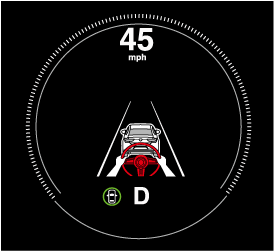
Active driving display (vehicles with active driving display)

-
If the steering wheel is held lightly, or depending on the road conditions, the system determines that you have released the steering wheel (not holding the steering wheel) even if you are holding it, and an alert is indicated on the multi-information display and the active driving display.
To resume operation
If the TJA is temporarily canceled, it will resume operation at the previously set speed by pressing the RES switch after all of the operation conditions have been met.
-
If the set speed is not indicated on the display, the system does not operate even if the RES switch is pressed.
-
After the operation, the steering assist operation may not operate for a period of 5 seconds at the most until the lane lines are detected or a vehicle ahead is recognized.
Turning off
When the TJA switch is pressed while the TJA is operating, the TJA turns off.
Stop Hold Control (Automatic Transmission)
While in headway control using the TJA, your vehicle will stop when a vehicle ahead stops. When the vehicle is stopped and the stop hold control operates, the TJA indicator light turns on.

-
Even if the TJA is temporarily canceled during stop hold control, the vehicle is held in its stopped position.
-
The parking brake is automatically applied and the vehicle is held in its stopped position when 10 minutes or longer have passed since the stop hold control operated. When this occurs, the TJA is temporarily canceled.
-
The brake lights turn on during stop hold control.
To resume driving
After the vehicle ahead starts moving while your vehicle is stopped under stop hold control, press the RES switch or depress the accelerator pedal to cancel the stop hold control and start driving.
-
When you resume driving by pressing the RES switch, your vehicle does not start moving until the distance between your vehicle and the vehicle ahead lengthens to the specified distance or farther.
-
If the TJA is temporarily canceled, depress the accelerator pedal and start driving the vehicle. If the TJA is temporarily canceled, you cannot resume driving by pressing the RES switch when there are no vehicles in front of your vehicle.
-
If the vehicle ahead starts moving within 3 seconds after your vehicle is stopped by the stop hold control, headway control will continue even if you do not resume driving your vehicle, such as by depressing the accelerator pedal.
Vehicle departure information
If you do not resume driving within a few seconds after the vehicle ahead starts moving during stop hold control, the multi-information display vehicle-ahead indication flashes to urge the driver to resume driving. If you do not resume driving after the indicator light flashes, a sound is activated to urge you to resume driving.
Stopping the Smart Brake Support (SBS) System Operation
The SBS can be changed to inoperable.
Refer to the Settings section in the Mazda Connect Owner's Manual.
When the SBS is canceled, the SBS OFF indicator light turns on.

When the ignition is switched OFF while the SBS forward drive detection is canceled, the SBS forward drive detection is automatically enabled the next time the ignition is switched ON.
360° View Monitor (Some Models)
Types of Images Displayed on the Screen
Top view/Front view
Displays the image of the area around the vehicle and the vehicle front.
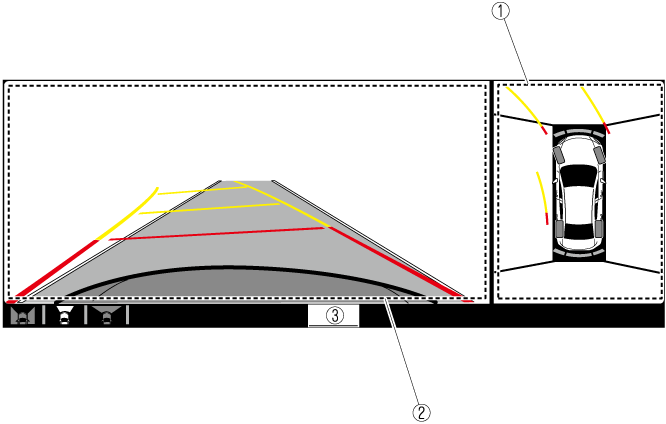
-
Top view screen
-
Front view screen
-
“Check surroundings for safety.” message is displayed
Top view/Front wide view
Displays the image of the area around the vehicle and the front of the vehicle (wide-area).
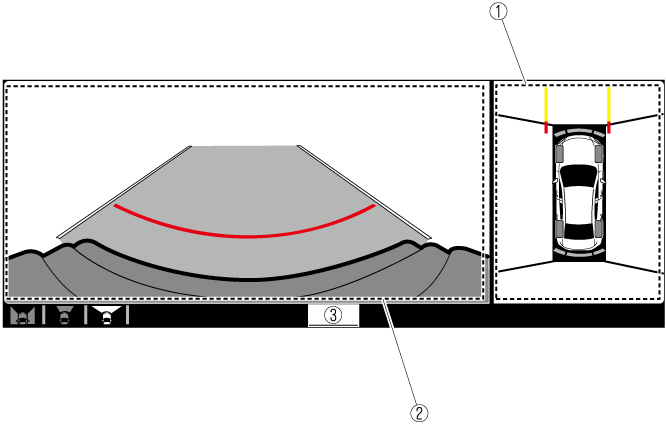
-
Top view screen
-
Front wide view screen
-
“Check surroundings for safety.” message is displayed
Side view
Displays the image of the left and right sides of the vehicle.
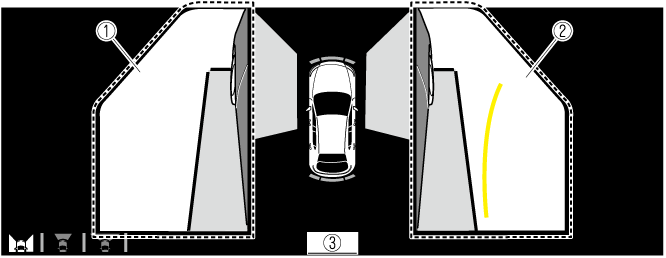
-
Left side view screen
-
Right side view screen
-
“Check surroundings for safety.” message is displayed
Top view/Rear view
Displays the image of the area around the vehicle and the rear of the vehicle.
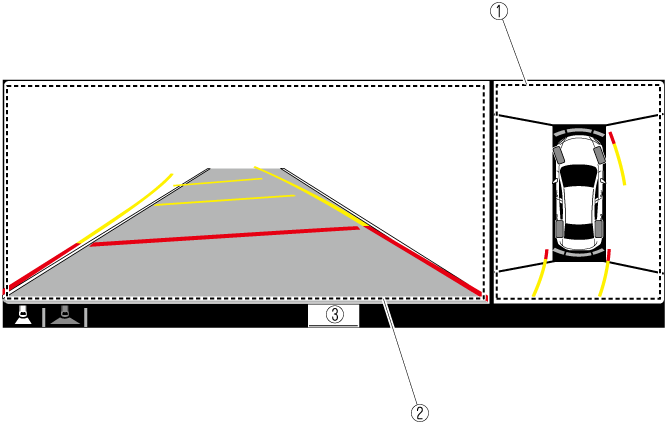
-
Top view screen
-
Rear view screen
-
“Check surroundings for safety.” message is displayed
Top view/Rear wide view
Displays the image of the area around the vehicle and the rear of the vehicle (wide-area).
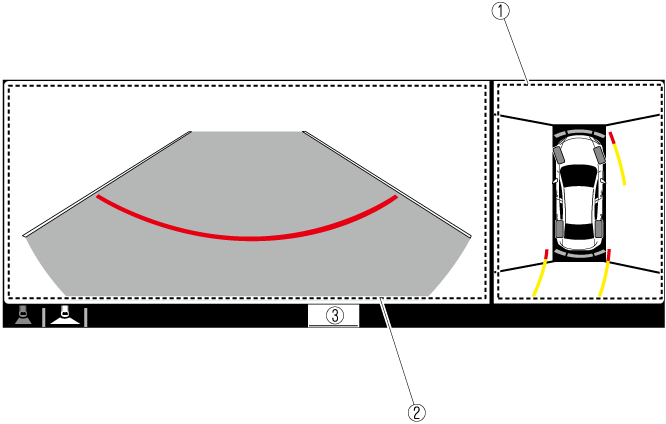
-
Top view screen
-
Rear wide view screen
-
“Check surroundings for safety.” message is displayed
Top View/Front View
Use the top view/front view to assist in checking the safety of the surrounding area when accelerating from a stop, parking, or stopping the vehicle.
Display range
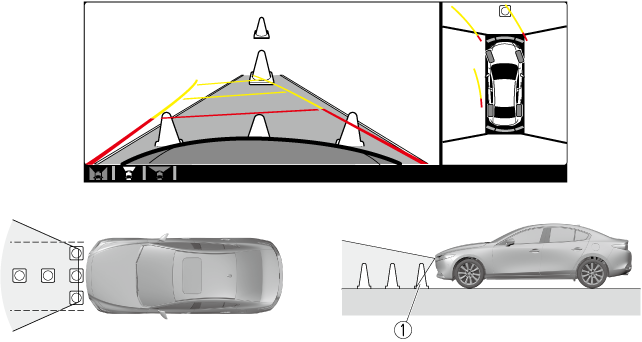
-
Target object
-
In the top view screen, the areas in black at the front and rear of the vehicle image and the seams where each of the camera images merge are blind spots.
-
Because images displayed in the top view screen are processed from each camera, the top view screen may display in the following ways.
-
Depending on the surrounding environment, the color of objects may be displayed on the screen in a color different from the actual one.
-
Depending on the surrounding environment, it may take a few seconds for the color of the screen display to adjust.
-
Obstructions displayed in the front view may not display on the top view screen.
-
If the position or angle of each camera changes due to tilting of the vehicle, the image may appear distorted.
-
Lines on the road may appear distorted at the seams where each of the camera images merge.
-
The screen area for each camera may appear bright/dark depending on the illumination level around any of the cameras.
-
Viewing the screen
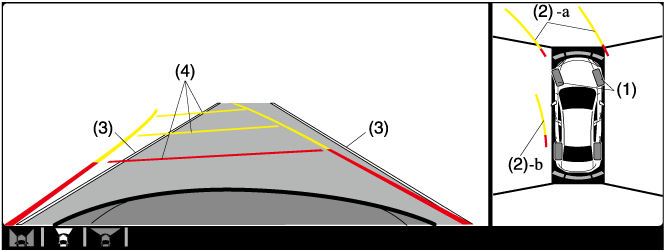
|
Display/Icon |
Content |
|
|---|---|---|
|
(1) |
Tire icon |
Indicates the tire direction. Moves in conjunction with the steering wheel operation. |
|
(2) |
Projected vehicle path lines (yellow & red) |
Indicates the approximate projected path of the vehicle. Moves in conjunction with the steering wheel operation. a) Indicates the path where the edge of the front bumper is expected to travel. b) Indicates the path where the inner side of the vehicle is expected to travel. |
|
(3) |
Extended vehicle width lines (blue) |
Indicates the approximate width of the vehicle. |
|
(4) |
Projected vehicle path distance guide lines (yellow & red) |
Indicates the distance (from front end of bumper) in front of the vehicle.
|
The parking sensor detection range has limitations. For example, obstructions closing in from the side and objects short in height may not be detected. Always confirm the safety around the vehicle visually when driving.
For details, refer to the parking sensor obstruction detection indication and warning sound.
Refer to Parking Sensor System (Search).
The setting can be changed so that the projected vehicle path lines are not displayed.
Refer to the Settings section in the Mazda Connect Owner's Manual.
How to use the projected vehicle path line function
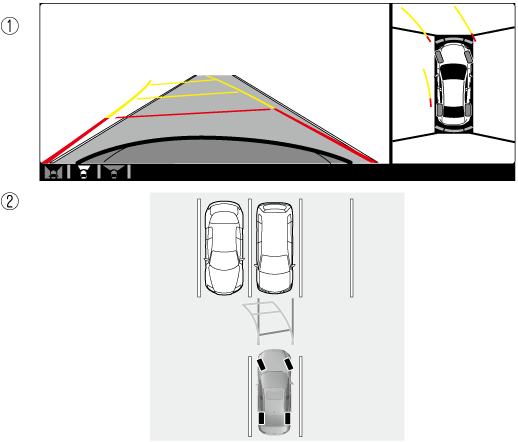
-
(Screen display)
-
(Actual condition)
Make sure that there are no obstructions within the projected vehicle path lines.
Drive the vehicle forward while turning the steering wheel so that no obstructions come within the projected vehicle path lines.
Front Side Radar Sensor (Some Models)
Rear Side Radar Sensor (Some Models)
Rear Side Radar Sensor
Your vehicle is equipped with rear side radar sensor. The following systems also use the rear side radar sensor.
-
Blind Spot Monitoring (BSM)
-
Rear Cross Traffic Alert (RCTA)
-
Smart Brake Support (SBS) reverse drive detection
The rear side radar sensors emit radio waves and detect the radio waves reflected off a vehicle approaching from the rear or an obstruction.
4–Door
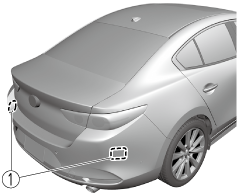
-
Rear side radar sensor
5–Door
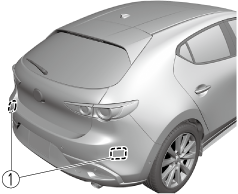
-
Rear side radar sensor
The rear side radar sensors are installed inside the rear bumper, one on each side.
Always keep the surface of the rear bumper near the rear side radar sensors clean so that they operate normally. Also, do not apply items such as stickers.
Refer to Exterior Care (Search).
If the rear bumper receives a severe impact, the system may no longer operate normally. Stop the system immediately and have the vehicle inspected at an Authorized Mazda Dealer.
-
The detection ability of the rear side radar sensor has limitations. In the following cases, the detection ability may lower and the system may not operate normally.
-
The rear bumper near the rear side radar sensor has become deformed.
-
Snow, ice or mud adheres to the rear side radar sensor on the rear bumper.
-
Under bad weather conditions such as rain, snow and fog.
-
-
Under the following conditions, the rear side radar sensor cannot detect target objects or it may be difficult to detect them.
-
Small motorcycles, bicycles, pedestrians, animals, shopping carts, and stationary objects on a road or a road side.
-
Vehicle shapes which do not reflect radar waves well such as empty trailers with a low vehicle height and sports cars.
-
-
Vehicles are shipped with the direction of the rear side radar sensor adjusted for each vehicle to a loaded vehicle condition so that the rear side radar sensor detect approaching vehicles correctly. If the direction of the rear side radar sensor has deviated for some reason, have the vehicle inspected at an Authorized Mazda Dealer.
-
For repairs or replacement of the rear side radar sensor, or bumper repairs, paintwork, and replacement near the radar sensors, consult an Authorized Mazda Dealer.
-
The radar sensors are regulated by the relevant radio wave laws of the country in which the vehicle is driven. If the vehicle is driven abroad, authorization from the country in which the vehicle is driven may be required.





